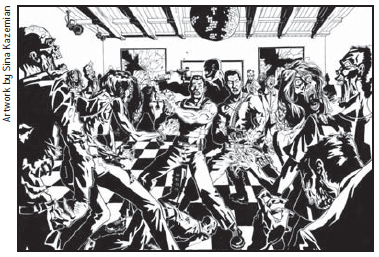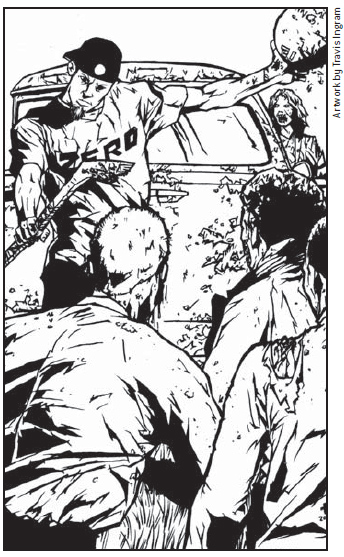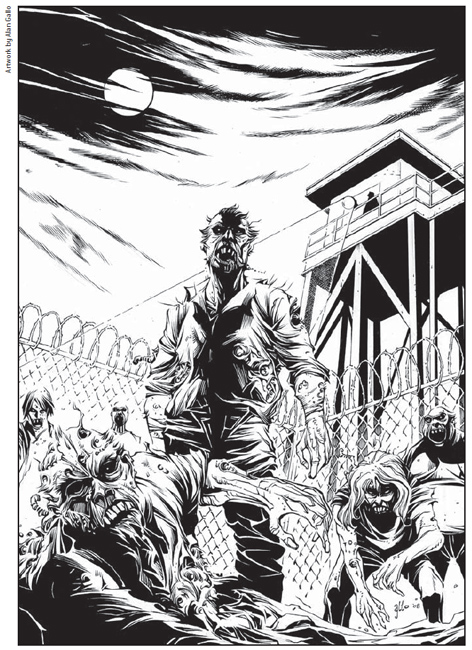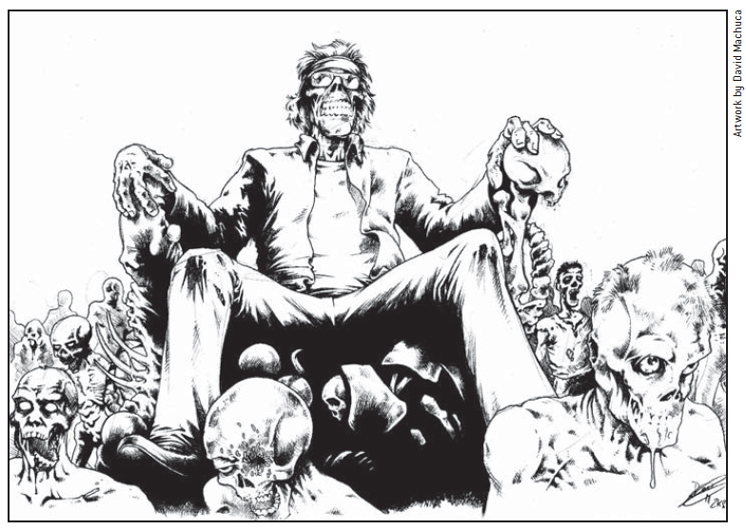Zombies (9 page)

One of the main reasons it took science so long to identify viral zombies as a separate classification is that the initial specimens appeared so similar in character to atomic zombies. All of the Chinese and Vietnamese outbreaks featured slow, moaning zombies. With their containment and elimination, few further tests were conducted. But as the years passed and the virus spread, different zombie outbreaks showed a worrying degree of individualism. Some zombies moved and reacted quicker. Others showed slightly more intelligence. Now, science understands this to be the result of Z-virus mutation. Today, there are 47 different recognized strands of Z-virus, and each produces a different variety of zombie. Luckily, even with this variation, all viral zombies still show enough similarities that they can be discussed under
the same classification. In fact, the differences generally manifest as varying levels of speed and intelligence and not as any truly unique features.

As mentioned, the first viral zombies mimicked atomic zombies in almost every way, except that they were not cannibalistic and reproduced through infection. These early viral zombies do still occasionally crop up, but their threat has mostly been contained. It is the newer “fast zombies” that now pose the greatest threat. Often called “aggressor zombies” in hunter circles, these undead are the most human-looking of all zombie varieties. At a distance it is nearly impossible to distinguish them from the living. A closer inspection reveals them to be unnaturally pale, with eyes rolled back into their heads. They almost always keep their mouths open and their teeth bared. In fact, the easiest way of recognizing a viral zombie, especially an aggressor, is how it charges directly at the nearest living person.

At the highest end yet recorded, aggressor zombies can run as fast as a living person. Moreover, with no functioning respiratory system or pain receptors, they are able to maintain a top sprinting speed for longer than most humans. In a straight footrace, aggressor zombies nearly always win. The same applies to hand-to-hand combat. These zombies can push their muscles to the limit longer than most humans. Considering that viral zombies only need to inflict a blood-wound, hand-tohand combat should be avoided at all costs.
Viral zombies do not use weapons. It is unclear if this is due to a lack of intelligence or just a function of their drive to spread infection. There are no reports of them using tools of any kind, and like most other zombies, they will continuously ram themselves against a door in order to break it down without ever attempting to turn a doorknob. That said, unlike atomic zombies, some of the more aggressive viral zombies can climb. They will not attempt to scale the side of a building or anything tricky, but will happily launch themselves up and over any small wall or fence that stands in a direct line between them and their prey.
Most viral zombies have decent sensory perception. Their eyesight is poor and mostly based on movement, but their hearing and sense of smell remain as acute as in life. Some varieties of viral zombie moan and respond to moans in much the same way as their atomic cousins, but this is less and less common. Most viral zombies, and almost all aggressor types, do not moan. Despite this, they still possess a type of herd mentality. Viral zombies tend to band together in order to hunt prey and often react to one another. Viral zombie herd mentality remains a hotly debated topic among necrovirologists, with numerous credible but conflicting theories competing for space in the journals.

Despite their great speed and strength, viral zombies remain slightly more susceptible to physical damage than most zombies. While a single shotgun blast to the chest will not take one out, multiple blasts often do the trick. Alternatively, a fully automatic assault rifle can tear them apart. Such methodology does require a heavy expenditure of ammunition and is relatively slow. Luckily, like atomic zombies, all varieties of viral zombie are vulnerable to the destruction of the brain. One clean head shot will take them down, and this remains the favored technique of most hunters. It should be noted however, that the increased speed of aggressor zombies can make this a very difficult shot indeed.
Humanity also possesses one weapon in the war on viral zombies that it doesn't have for other types: anti-viral drugs. In 2002, Dr Hall Moore and his team at the University of Maryland created the first viable anti-Z-virus drug. While the drug could not be turned into a vaccine, it could be applied to a newly infected host before death, and it gave the victim at least a 50 percent chance at survival. Today, this drug has been improved to 90 percent effectiveness if applied within the first hour.
Mankind cannot grow over-dependent on this miracle drug. The Z-virus is a constantly mutating and evolving entity. It needs to be continuously studied and the anti-viral drugs modified to keep pace. Also, this anti-virus remains expensive to produce and difficult to store. For now, it remains the domain of governments and their containment teams.
Other than the hope for more and better drugs, there is little mankind can do to prevent viral zombies. Governments must focus on quick containment of outbreaks; individuals should try their best not to get bitten.
B
EST METHOD OF PREVENTION:
A
NTI
-Z-
VIRUS DRUG
Â
14
For the most complete account of the unfortunate backpackers see
Through the Land of the Dead
by Abe Davies, Yukon Ink, 1974.
Many within the scientific community will scoff at my inclusion of a section on zombie masters, but considering the rising tide of evidence, I believe it would be neglectful not to at least discuss the possibility of their existence. Traditionally, the term “zombie master” was irregularly applied to necromancers who had assembled a large force of zombie minions, but in the last decade it has become more commonly associated with a possible viral zombie phenomenon. Today's zombie master generally refers to a zombie Typhoid Mary, a living human who carries the zombie virus.
To date, no official study can confirm the existence of a human carrier. In fact, according to the official record, no one has ever survived infection from a zombie virus without the quick application of an anti-virus. But a lack of scientific documentation does not mean human carriers don't exist. In the last ten years, there have been more than a dozen zombie survivor accounts that at least hint at the possibility. The first comes from the diary of Joanna Blitch, who survived for 12 days inside an office building during the 2002 “Mooresville Outbreak”:
â¦overnight Casey turned into one of them, but was killed before she could hurt anyone else. Casey had never been touched by one of them, never bitten or clawed. But just the day before she'd applied bandages to Kevin's arm after he'd cut himself on the glass. People began to talk, to say that Kevin must be infected, even though he showed no signs. During the debate, Kevin ran for the door and flung himself out into the night. We waited to hear his screams, but there was only silence.
15
Certainly this account is far from conclusive, but it is just one of several that tell a similar story. One of the most famous comes from Matthew Wright, who survived an outbreak in the English Midlands:
I saw him standing there, surrounded by zombies, a terrifying smile on his face. It was clear he wasn't one of them. He still had intelligence in his eyes. But they didn't attack him. At first, they seemed to crowd around him to protect him. Then he raised his hand and pointed at us, and the zombies began to charge.

Mr Wright's account
16
is notable for two reasons; first because it was the first account to be corroborated by independent witnesses, but more importantly, it introduced a new possibility to the world of zombie studies. In none of the varied accounts of possible zombie Typhoid Marys is the suspected carrier killed by zombies. In fact, in several cases, including Mr Wright's, the zombies seem to protect and even
obey
the carrier.
The implications of a human mind controlling a viral zombie horde is worrisome in the extreme, and that has perhaps led some within the community to stick their heads in the sand and deny the possibility without a thorough investigation. Despite the admitted lack of concrete evidence, the only counter-argument seems to hinge on the impossibility of communication between a living human and a viral zombie. Of course, this argument overlooks the ongoing debate about the viral hive mind.
As discussed in the previous chapter, some varieties of viral zombie do not moan, and yet they still seem to move in the same direction and “respond” to other zombies that have identified potential prey. Whether this is the result of some kind of psychic connection or has a more tangible scientific explanation, there seems no good reason that a human carrier of the virus might not also be incorporated into this hive mind. If this were the case, the complex, individualistic human mind might easily come to dominate the narrow thinking of a zombie horde.
